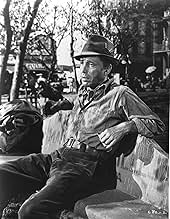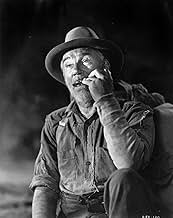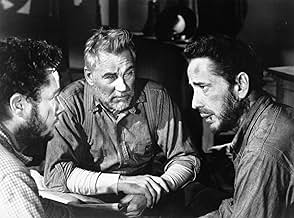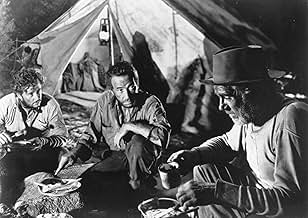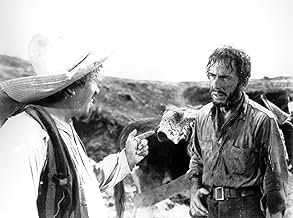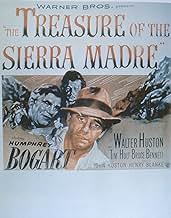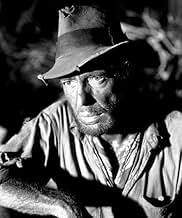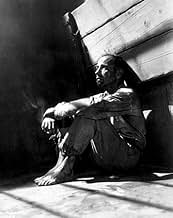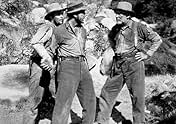Le Trésor de la Sierra Madre
Titre original : The Treasure of the Sierra Madre
- 1948
- Tous publics
- 2h 6min
Deux Américains à la recherche d'un emploi au Mexique convainquent un ancien prospecteur de les aider à chercher de l'or dans les montagnes de la Sierra Madre.Deux Américains à la recherche d'un emploi au Mexique convainquent un ancien prospecteur de les aider à chercher de l'or dans les montagnes de la Sierra Madre.Deux Américains à la recherche d'un emploi au Mexique convainquent un ancien prospecteur de les aider à chercher de l'or dans les montagnes de la Sierra Madre.
- Réalisation
- Scénario
- Casting principal
- Récompensé par 3 Oscars
- 18 victoires et 5 nominations au total
Barton MacLane
- Pat McCormick
- (as Barton Mac Lane)
Arturo Soto Rangel
- Presidente
- (as A. Soto Rangel)
Manuel Dondé
- El Jefe
- (as Manuel Donde)
José Torvay
- Pablo
- (as Jose Torvay)
Robert Blake
- Mexican Boy Selling Lottery Tickets
- (non crédité)
Guillermo Calles
- Mexican Storeowner
- (non crédité)
Roberto Cañedo
- Mexican Lieutenant
- (non crédité)
Spencer Chan
- Proprietor
- (non crédité)
Jacqueline Dalya
- Flashy Girl
- (non crédité)
Ralph Dunn
- Flophouse Bum
- (non crédité)
Ernesto Escoto
- Mexican Bandit
- (non crédité)
Résumé
Reviewers say 'The Treasure of the Sierra Madre' is a critically acclaimed classic, lauded for its profound examination of greed, betrayal, and human nature. John Huston's direction and screenplay, alongside exceptional performances by Humphrey Bogart, Walter Huston, and Tim Holt, are often celebrated. The film's authentic atmosphere, intricate character studies, and moral complexities deeply resonate. Although some critique its pacing and subplots, most regard it as a timeless masterpiece noted for its psychological depth and thematic richness.
Avis à la une
This film made a huge impression on me when I first saw it at the age of 15 or 16. A recent rewatching on DVD really served to bring home for me what makes this film so special.
The whole thing is quite good, but it really hits you when Howard goes off to celebrate with the Indians, leaving Dobbs and Curtin to care for his gold and burros. The ensuing scenes of their spiraling mistrust and tension are absolutely spellbinding--the kind of thing that makes you lean forward in your seat just to get your eyes a little closer to the raw humanity unfolding in front of you. Their paranoia, the way you can SEE scenarios of betrayal dancing in their eyes, Dobbs' burgeoning madness--these are the moments that make this film one for the ages.
At its best, film noir (which this most certainly is--Western surroundings or no) makes the viewer complicit in the evil depicted on screen. We find ourselves scheming and plotting in our heads along with the unsavory characters we are watching--we start to feel the same temptations and desires that they do. "Treasure of the Sierra Madre" accomplishes this bond with the audience as well as any film you are likely to see.
A magnificent film--one of the few great screen tragedies.
The whole thing is quite good, but it really hits you when Howard goes off to celebrate with the Indians, leaving Dobbs and Curtin to care for his gold and burros. The ensuing scenes of their spiraling mistrust and tension are absolutely spellbinding--the kind of thing that makes you lean forward in your seat just to get your eyes a little closer to the raw humanity unfolding in front of you. Their paranoia, the way you can SEE scenarios of betrayal dancing in their eyes, Dobbs' burgeoning madness--these are the moments that make this film one for the ages.
At its best, film noir (which this most certainly is--Western surroundings or no) makes the viewer complicit in the evil depicted on screen. We find ourselves scheming and plotting in our heads along with the unsavory characters we are watching--we start to feel the same temptations and desires that they do. "Treasure of the Sierra Madre" accomplishes this bond with the audience as well as any film you are likely to see.
A magnificent film--one of the few great screen tragedies.
This film is a sharp-edged study of the effects of greed on otherwise normal men, and one man in particular: Bogart's Fred C. Dobbs. Dobbs and Bob Curtin (Tim Holt) are down and out and meet up with prospector Howard (Walter Huston). When Dobbs wins a lottery, he uses the proceeds to finance a trip for the three to central Mexico to search for gold.
The three have to deal with the lawlessness of central Mexico at the time - bandits were actually on the loose in that country killing anybody with stuff, and taking that stuff. The Federales were a violent solution to a violent problem - killing the bandits after a summary judgement and the bandits having dug their own graves. So our trio not only have to worry about bandits once they strike gold, they have to worry about the darkness of their own souls.
In the beginning, Bogart's Fred C. Dobbs is a decent guy who does not take advantage of others. Dobbs only takes his money from the guy that wouldn't pay and he does share his lottery ticket and is generous with his fellow miners, but as greed begins to take root in him, little by little we see his goodness eaten away. It's a great credit to the writing and Bogart's skills that this is done gradually and played out over time. Incidentally, that's director John Huston "staking him to a meal". One of the best director cameos ever (although Polanski in Chinatown is equally great)!
Dobbs overestimates himself and the fallibility of human nature. Walter Hustons character freely admits what gold could do to any of them including himself. Dobbs is sure it will never happen to him, but he's never had anything, so he's never faced temptation, and when he falls it's a long way down.
This may be Tim Holt's finest performance - it was probably his finest opportunity given he had spent years laboring as a B western star on the RKO lot. Walter Huston as the prospector, minus his dentures and plus a bunch of pounds and with holes in his clothes is not the debonair fellow you are used to seeing in film . If Mary Astor's character in Dodsworth could have thought this was the future appearance of the man she loved, would she have taken her gondola in the other direction? I guess we'll never know.
Highly recommended as one of the great character studies in which several characters get studied in detail.
The three have to deal with the lawlessness of central Mexico at the time - bandits were actually on the loose in that country killing anybody with stuff, and taking that stuff. The Federales were a violent solution to a violent problem - killing the bandits after a summary judgement and the bandits having dug their own graves. So our trio not only have to worry about bandits once they strike gold, they have to worry about the darkness of their own souls.
In the beginning, Bogart's Fred C. Dobbs is a decent guy who does not take advantage of others. Dobbs only takes his money from the guy that wouldn't pay and he does share his lottery ticket and is generous with his fellow miners, but as greed begins to take root in him, little by little we see his goodness eaten away. It's a great credit to the writing and Bogart's skills that this is done gradually and played out over time. Incidentally, that's director John Huston "staking him to a meal". One of the best director cameos ever (although Polanski in Chinatown is equally great)!
Dobbs overestimates himself and the fallibility of human nature. Walter Hustons character freely admits what gold could do to any of them including himself. Dobbs is sure it will never happen to him, but he's never had anything, so he's never faced temptation, and when he falls it's a long way down.
This may be Tim Holt's finest performance - it was probably his finest opportunity given he had spent years laboring as a B western star on the RKO lot. Walter Huston as the prospector, minus his dentures and plus a bunch of pounds and with holes in his clothes is not the debonair fellow you are used to seeing in film . If Mary Astor's character in Dodsworth could have thought this was the future appearance of the man she loved, would she have taken her gondola in the other direction? I guess we'll never know.
Highly recommended as one of the great character studies in which several characters get studied in detail.
Tampico sets the scene for the start of speculation, Fred C. Dobbs is out of cash and his luck is in cessation, but an encounter in flophouse, and big dreams emerge and arouse, as a plan is born with Howard, and a fellow who's called Curtin. Into hills laden with gold, our companions then embark, finding seams that come alive with golden riches to impart, building up substantial fortune, thinking soon they will be tycoons, but there's one who's trust is waning and has sores that start to smart. The journey back becomes a challenge to them all, as one by one the group is scattered, battered, stalled, will their work be well rewarded, will endeavours all be thwarted, either way, you will be engaged, and quite possibly enthralled.
Bogarts best performance.
Bogarts best performance.
The Treasure of the Sierra Madre (1948)
This is a weirdly contemporary film. I mean, it's certainly set in the past, and it's made in the heyday of Hollywood genius top to bottom which is long gone. But because it's about this old time and about raw black and white issues (often), the film and the filming are really appropriate. The whole thing just fits, and beautifully.
And I mean beautiful. As rugged as it all is--the landscape as well as the beards, all very real--the movie is lyrically filmed. The story is told with visual clarity. And the script, speaking of story, is sophisticated and believable. In all, under the direction of legend John Huston, this is a spot on terrific movie.
Of course, there are two actors who are just amazing in their roles (and a third, Tim Holt, who is just fine, if not stellar). I mean of course Walter Huston, who nearly steals the show in every scene. He's a character, but not a caricature. His wisdom--real wisdom, based on smart observation over decades of experience--is sterling. Great stuff, well put. And of course he's the father of the director, which is a fun, and slightly Freudian twist. He gives one of the great performances of the decade.
Humphrey Bogart is not far behind, actually. If you like him in Maltese Falcon or Casablanca, you'll be surprised at first by the scruffy, raw character played here. But it's clear-headed, brilliantly delivered Bogart all the way, and a joy to watch him really act. See it for him, too.
Then there is the story itself, which is as important now as ever. That is, what matters in life? And what is the price to pay to get it? It's all rather bold and emotional even though it's delivered by some rough guys out of money prospecting in the wilderness of Mexico.
Are there downsides here? I suppose. You certainly can wonder about the way the Mexicans--good ones and banditos both--are portrayed. I think it's not bad, tinged with clichés, of course, but in Spanish without translation or stilted half-English, so it's the real thing. And no subtitles. Nicely done for an early Hollywood affair. Huston, the son, the director, if you don't know, is famous for doing things raw and right and slightly off the charts. He is making a commercial film, to be sure, but it has many small aspects that are just not pandering to anyone. This makes it work.
I'm sure to some this is a masterpiece. I'm giving that some thought. See it.
This is a weirdly contemporary film. I mean, it's certainly set in the past, and it's made in the heyday of Hollywood genius top to bottom which is long gone. But because it's about this old time and about raw black and white issues (often), the film and the filming are really appropriate. The whole thing just fits, and beautifully.
And I mean beautiful. As rugged as it all is--the landscape as well as the beards, all very real--the movie is lyrically filmed. The story is told with visual clarity. And the script, speaking of story, is sophisticated and believable. In all, under the direction of legend John Huston, this is a spot on terrific movie.
Of course, there are two actors who are just amazing in their roles (and a third, Tim Holt, who is just fine, if not stellar). I mean of course Walter Huston, who nearly steals the show in every scene. He's a character, but not a caricature. His wisdom--real wisdom, based on smart observation over decades of experience--is sterling. Great stuff, well put. And of course he's the father of the director, which is a fun, and slightly Freudian twist. He gives one of the great performances of the decade.
Humphrey Bogart is not far behind, actually. If you like him in Maltese Falcon or Casablanca, you'll be surprised at first by the scruffy, raw character played here. But it's clear-headed, brilliantly delivered Bogart all the way, and a joy to watch him really act. See it for him, too.
Then there is the story itself, which is as important now as ever. That is, what matters in life? And what is the price to pay to get it? It's all rather bold and emotional even though it's delivered by some rough guys out of money prospecting in the wilderness of Mexico.
Are there downsides here? I suppose. You certainly can wonder about the way the Mexicans--good ones and banditos both--are portrayed. I think it's not bad, tinged with clichés, of course, but in Spanish without translation or stilted half-English, so it's the real thing. And no subtitles. Nicely done for an early Hollywood affair. Huston, the son, the director, if you don't know, is famous for doing things raw and right and slightly off the charts. He is making a commercial film, to be sure, but it has many small aspects that are just not pandering to anyone. This makes it work.
I'm sure to some this is a masterpiece. I'm giving that some thought. See it.
Two penniless Americans (Humphrey Bogart and Tim Holt) during the 1920s in Mexico join with an old-timer (Walter Huston, the director's father) to prospect for gold. The old-timer accurately predicts trouble, but is willing to go anyway. The film is fictional, but presents a very realistic scenario: By the 1920s the violence of the Mexican Revolution had largely subsided, although scattered gangs of bandits continued to terrorize the countryside. The newly established post-revolution government relied on the effective, but ruthless, Federal Police, commonly known as the Federales, to patrol remote areas and dispose of the bandits. Foreigners, like the three American prospectors, were at very real risk of being killed by the bandits if their paths crossed. The bandits, likewise, were given little more than a "last cigarette" by the army units after capture, even having to dig their own graves first.
The film shows the Americans doing just about anything for money: drilling oil, digging for gold, begging and more. And once gold comes into the picture, the men who once claimed they were not greedy see things differently. Bogart actually goes mad, after he gets greedy and paranoid... during which he encounters a gila monster! The most memorable scene of this film involves the bandits, who don't need any "stinking badges". While the line is much more quotable in "Blazing Saddles", we couldn't have "Blazing Saddles" (or "UHF") without this film... just about everyone, even those who never saw or heard of "Sierra Madre", knows the badges line.
Humphrey Bogart's best film is probably "Casablanca", but this one features him in a nice, rough exterior. Yes, sometimes leading men have beards and are covered in dirt. Pretty boys do not stay pretty boys after digging in the hills, or at least that wouldn't be realistic. This film does a fine job trying to "keep it real", so we have to commend Huston not only on his directing, but his wonderful location scouting.
The film shows the Americans doing just about anything for money: drilling oil, digging for gold, begging and more. And once gold comes into the picture, the men who once claimed they were not greedy see things differently. Bogart actually goes mad, after he gets greedy and paranoid... during which he encounters a gila monster! The most memorable scene of this film involves the bandits, who don't need any "stinking badges". While the line is much more quotable in "Blazing Saddles", we couldn't have "Blazing Saddles" (or "UHF") without this film... just about everyone, even those who never saw or heard of "Sierra Madre", knows the badges line.
Humphrey Bogart's best film is probably "Casablanca", but this one features him in a nice, rough exterior. Yes, sometimes leading men have beards and are covered in dirt. Pretty boys do not stay pretty boys after digging in the hills, or at least that wouldn't be realistic. This film does a fine job trying to "keep it real", so we have to commend Huston not only on his directing, but his wonderful location scouting.
Le saviez-vous
- AnecdotesJohn Huston stated that working with his father on this picture and his dad's subsequent Oscar win were among the favorite moments of his life.
- GaffesAlthough set in the 1920s, many of the cars on the streets of Tampico are of 1930s and 1940s vintage; likewise, women, when prominently seen, are groomed and dressed strictly in the style of the 1940s.
- ConnexionsFeatured in The Screen Writer (1950)
- Bandes originalesBelieve Me If All Those Endearing Young Charms
(1808) (uncredited)
Music traditional
Played on harmonica by Walter Huston
Meilleurs choix
Connectez-vous pour évaluer et suivre la liste de favoris afin de recevoir des recommandations personnalisées
Détails
- Date de sortie
- Pays d’origine
- Langues
- Aussi connu sous le nom de
- El tesoro de la Sierra Madre
- Lieux de tournage
- Kernville, Californie, États-Unis(Kelly's Rainbow Mine)
- Société de production
- Voir plus de crédits d'entreprise sur IMDbPro
Box-office
- Budget
- 3 000 000 $US (estimé)
- Montant brut aux États-Unis et au Canada
- 5 014 000 $US
- Week-end de sortie aux États-Unis et au Canada
- 144 074 $US
- 14 janv. 2018
- Montant brut mondial
- 5 014 000 $US
- Durée2 heures 6 minutes
- Couleur
- Rapport de forme
- 1.37 : 1
Contribuer à cette page
Suggérer une modification ou ajouter du contenu manquant

Lacune principale
What was the official certification given to Le Trésor de la Sierra Madre (1948) in Japan?
Répondre

